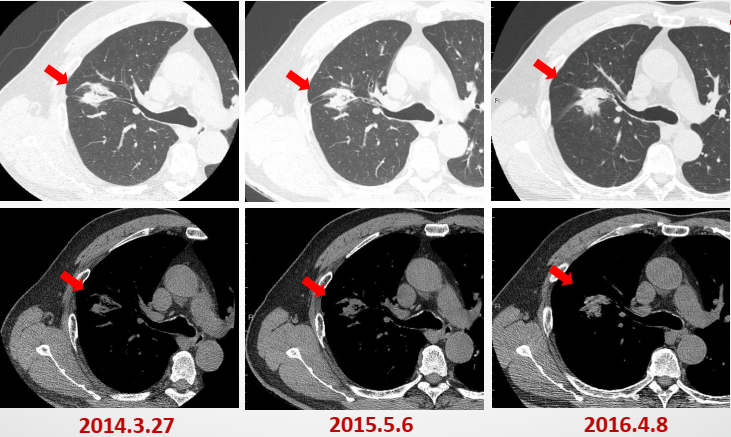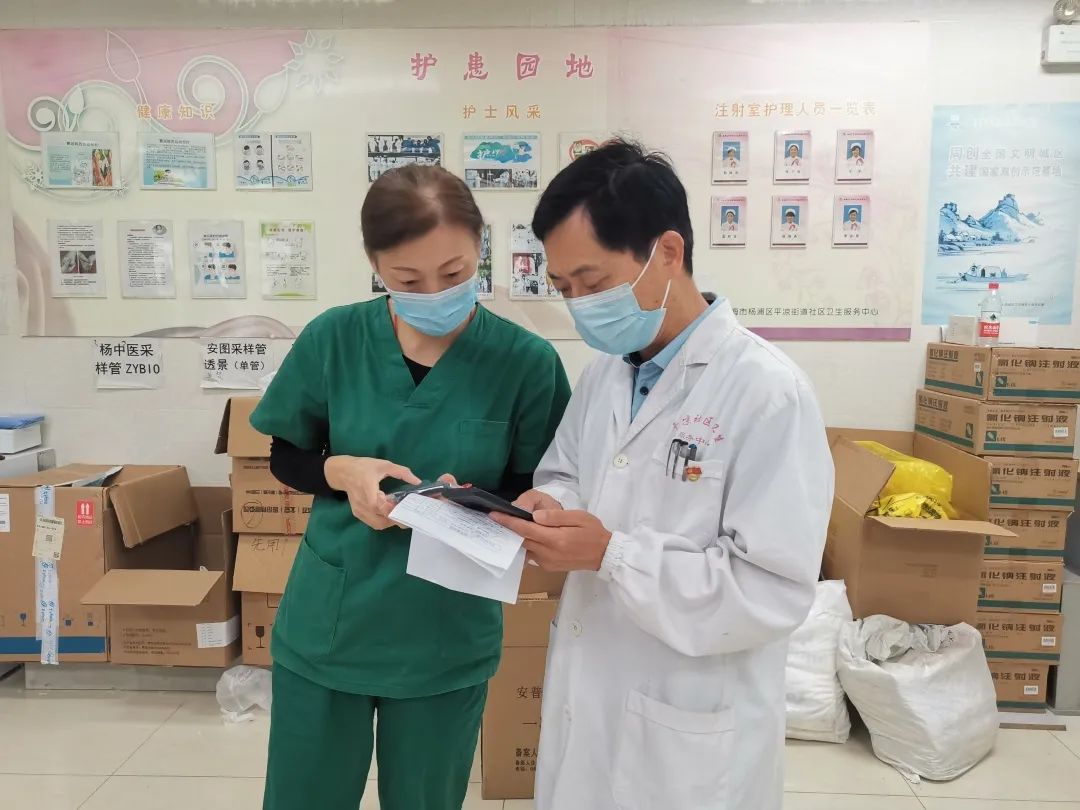The treatment of Aohinib+Savacibinib, helping patients with advanced lung adenocarcinoma to achieve nearly 6 years of survival!
Author:Cancer Channel of the Medical Time:2022.07.12
*For medical professionals for reading reference

Wonderful cases of lung cancer sharing, one -click check!
Patients with first diagnosis of right lung adenocarcinoma with negative genes with the right bronchial lymph node metastasis, right lung metastases, pleural metastasis, and left lung grinding glass stoves (malignant) (CT4N1M1B, stage IV). Patients accept four cycles of Peime Qucei+Calpin+Bevarzab, and the effect of stabilizing the disease (SD). The tissue genetic test results during treatment showed that the patient was an EGFR No. 21 outer L858R mutation and EGFR amplification. After 4 cycles of first -line treatment, the treatment was replaced by Geffitinib+Bevarzumab. The curative effect was evaluated as a partial relief (PR), and there was no progressive survival (PFS) for 3 years and 10 months. The patient's right lung nodule slowly increases from the previous to increase the dose for the patient, but the curative effect is not good. After 9 months of treatment, the patient performed a second -generation blood sequencing (NGS) test. Detinib+Bevarzumab, the curative effect is SD.
After 4 months of treatment, the lung residial lesions were abolished, and the lung puncture biopsy testament was performed before surgery. The tissue genetic testing reminded the patients to mutchay the EGFR No. 21 outer appendage L858R and Met 14 outer appende. Patients were treated with Savininib+Osicinib, and PFS was greater than 9 months. As of now, the total survival of patients (OS) is nearly 6 years. The case was provided by Professor Oman, Professor Eman, the First Affiliated Hospital of Dalian Medical University, and invited Professor Liu Jiwei, the First Affiliated Hospital of Dalian Medical University to comment.
Resume
basic situation:
The patient, 63 years old. In April 2016, "March with a dry cough with the right chest pain in March, heated 10 days" was visited in our hospital respiratory department.
Previous history: In 2015, the diagnosis of room tremor radio frequency discharge, and in 2000, due to appendicitis, appendix removing surgery.
Personal history: 10 years of smoking, 10 years/day, and quit smoking in 2015.
March 27, 2014 Sports Terminal CT: Left Pulmonary Speed Glass Shadow (8.9mm), and the right lung spots (3cm).
On May 6, 2015, the chest HRCT: The horizontal spots of the upper lung lobe are not except the viciousness. The viciousness is not except.
On April 8, 2016, chest CT: A sheet -shaped high -density shadow can be seen in the horizontal cracking area of the right lung, 3.3cm*2.4cm, irregular morphology, partially connected with pleura, considering the possibility of inflammation and lesions; The latter -shaped mixed density grinding glass shadow is seen at the back of the upper leaf tip.


Figure 1. March 27, 2014 (left), May 6, 2015 (middle), April 8, 2016 (right) chest CT examination results
May 4, 2016 PET/CT: The upper lung leaf cluster, the FDG metabolism is significantly increased, first consideration of lung cancer; the fdg metabolic high lymph nodes next to the bronchial bronchial side; After 11, the ribs of FDG metabolic increase stoves; there are more nodules on the right lung lobe, and some FDG metabolism increases. All of them are first considered metastasis; left lung tip grinding glass stoves, no FDG metabolism increases.
May 6, 2016 Ultrasonic tracheal mirror (EBUS): Failure to detect and right lung lesions.
Symptoms of scrubbing liquids: See adenocarcinoma cells.
Blood NGS detection: No clear drive gene mutations are seen.
Diagnosis results: right lung adenocarcinoma (CT4N1M1B, IV), driving gene negative, lymph node metastasis of the right bronchial side, internal ruling in the right lungs, pleural metastasis, and left lung grinding glass stove (malignant possibility).

Patients with first diagnosis of right lung adenocarcinoma with negative genes with the right bronchial lymph node metastasis, right lung metastases, pleural metastasis, and left lung grinding glass stoves (malignant) (CT4N1M1B, stage IV). In August 2016, the patient received four cycles of the first -line treatment of Peimev+Card Platinum+Bevarzab, and the curative effect was evaluated as a narrow SD. The tissue gene test was performed during the treatment, and the results showed that the patient was an EGFR No. 21 external L858R mutation and EGFR amplification. Therefore, the patient began to be changed from September 4, 2016 to EGFR inhibitors Geffitinib combined with Bervarzumab maintenance treatment. During the period, the adverse reactions were controllable. The efficacy was evaluated as PR. The PFS was 3 years and 10 months.
Review in July 2020 showed that the patient's right lung nodule increased slowly from the previous year, and increased the dose of Gefitinnib to 500mg QD PO to the patient, but the curative effect was not good. On October 20, 2020 and April 16, 2021 Show the patient's right lung nodule slowly increased. On April 26, 2021, the patient performed the blood NGS test without T790M mutations, and then replaced it with Oshitinib+Bevarzab therapy. The efficacy evaluation was SD.
On August 25, 2021, patients with lung residial lesions were treated with radio frequency ablation after 4 months of treatment. The tissue genetic testing prompts EGFR 21 outer sub -l858R mutation and Met 14 exterior sub -jump mutation. On September 26, 2021, patients began to undergo the treatment of the two targets of Oshitininib combined with Saivininib. The adverse reactions were controllable, and PFS was greater than 9 months. Review on February 15, 2022 and May 12, 2022 showed that the patient's right thoracic effusion increased from the front, and the remaining lesions were stable. In the past two months, patients performed twice of chest puncture, seeing light blood thoracic effusion, thoracic water cytology, and malignant effusion. The thoracic injection of Bevarzumab combined with carboplatin treatment, but chest water control can be continued. Provide experts
Professor Wang Oman: Dynamic gene testing achieves precise treatment, helping patients to achieve long survival
About half of the patients of non -small cell lung cancer (NSCLC) have EGFR mutations. In recent years, with the continuous iteration of EGFR-TKI, the survival time of EGFR mutations NSCLC patients has gradually extended. In the first diagnosis of this patient, the blood NGS was used to detect the negative of the gene. The first -line treatment selected chemotherapy combined with anti -vascular production therapy, and the curative effect was evaluated as SD. During the first -line treatment, the patient conducted a tissue NGS test, and the results showed that the patient was EGFR No. 21 outer L858R mutation and EGFR amplification. After receiving the four -cycle first -line treatment, the patient was changed to the maintenance treatment of Geffitinib combined with Bevarzab, so that the patient had a good opportunity for targeted therapy. The PFS reached 3 years and 10 months.
In addition to the detection of conventional EGFR and ALK genes, MET14 outer appearance jump mutation is also an important primary carcinogenic driving gene mutation, and the incidence in lung cancer is about 3%-4%[1]. National Guidelines such as the National Comprehensive Cancer Network (NCCN) [2] and the China Clinical Oncology Society (CSCO) [3] recommend NSCLC patients at home and abroad routinely detect MET14 out -of -the -art sub -jump mutations. When the patient conducted the NGS test for the second time, the results showed that the patient had EGFR-TKI secondary pharmaceutical resistance, and there was a mutation of EGFR No. 21 outer L858R mutation and Met14 outer sub-jump mutation. After treatment with Oshitinib and Savacinib, the patient's PFS was more than 9 months, and the safety was controllable.
In the era of precision treatment, precision testing is the prerequisite. Precision testing can provide accurate guidance for the selection of subsequent treatment plans. In the process of treatment, this patient passes the dynamic gene test. And the possibility of long survival, which also reminds us of the importance of dynamic gene testing in clinical clinical clinical.
Expert Reviews
Professor Liu Jiwei: Saverninib rewrite China's MET target treatment pattern, dual target treatment prospects are expected
In this case, patients with the 2158R mutation of EGFR 21 outer appende L858R and MET14 outer jumping mutations are relatively rare in previous treatment. Patients with NSCLC with mutations in MET genes are far lower than patients with negative driving gene negatives, and OS is short. Even if the combined PD-L1 has high expression, it has a poor response to immunotherapy. After EGFR-TKI secondary drug resistance, the patient needs a precise and efficient drug treatment strategy.
On June 22, 2021, Savidi was approved to be listed in China to treat patients with local advanced or metastasis NSCLC patients with the existence of Met14 outer jumping mutations. Savininib broke the dilemma available in the previous MET sites without medicine, and provided new treatment options for Chinese MET mutant patients. In the 2021 version of "CSCO Non -cell Lung Cancer Diagnosis and Treatment Guidelines", Savininib is also listed as a recommended drug for the II -level jumping mutation of MET14 outer14.
Savidini Treatment MET14 outer outer sub -jump mutant lung sarcoma -like cancer or other NSCLC subtype phase II clinical studies show that in the tumor efficacy assessment set (TRES), the ORR treated by Savidi is 49.29%, and Disease Control rate (DCR) is 93.4%, the median PFS is 6.9 months, and the middle OS is 12.5 months [4,5]. The study reminds that Savinini has an exact effect on patients with NSCLC in Met14 outer appearance. At the same time, Savotinib showed good security and tolerance in the study, and the treatment related adverse reactions were mostly 1-2. The safety of Savacinib has also been confirmed in the treatment process of patients in this case. The patient's back line is treated with the two targets of Oshitinib united Savininib, which can be controlled by adverse reactions.
At present, many studies are exploring the efficacy and safety of patients with Oshitininib for the progress of Oshitinib the treatment of Oshitinib the treatment. In the future, with the announcement of the results of the research, they will further accumulate double accumulation. Evidence of target therapy helps to guide clinical practice.
At present, patients with new thoracic effusion, cytological pathology is confirmed as a malignant effusion, and no MET14 vitamin jump mutations are not seen in the wax block of the chest water cells. In the future, the treatment plan needs to be further adjusted to seek long -term survival for patients. It is hoped that in the future, more and more high -efficiency and low -toxic drugs like Savininib can be put into clinical practice to improve the current status of survival for more patients with lung cancer patients.
Introduction to case review experts
Professor Liu Jiwei

First Affiliated Hospital of Dalian Medical University
Director of Oncology Teaching and Research Office, Director of the First Department of Oncology
Executive Director of the China Clinical Oncology Society (CSCO)
CSCO-Tumor Cardiology Professional Committee Chairman
CSCO-Deputy Chairman of the Professional Committee of Pulmonary Cancer
CSCO-Deputy Chairman of the Professional Committee of Symnoma Tumor
Experts of the National Health and Family Planning Commission of Cancer Reasonable Medicine Expert Committee
Member of the Cancer Branch of the Chinese Medical Association
Member of the China Anti -Cancer Association Anti -Cancer Drug Research Committee
It has been engaged in clinical medical care, teaching and scientific research in tumors for nearly thirty years. He has studied for further studies at the National Cancer Center of Kyushu and Northwestern University of the United States.
Introduction to experts
Professor Wang Oman

Deputy Chief Physician, Doctor of Oncology
The Department of Oncology, Affiliated to the First Affiliated Hospital of Dalian Medical University
Member of the Chinese Clinical Oncology Society (CSCO) Biliary Tumor Special Committee
CSCO Oncology Heart Disease Special Committee member
Youth Member of the Chinese and Western Medicine Integrated Cancer Professional Committee of China Anti -Cancer Association
Member of the Professional Committee of Precision Medicine and Big Data of the Liaoning Biological Society
Member of the Liaoning Provincial Society of Nutrition Society
Member of the Dalian Oncology Society
The first CSCO 35 UNDER 35 is the most potential for young tumor doctors.
Prested 1 National Nature Fund Youth Fund and 1 Doctor Liaoning Provincial Doctoral Fund
Published 14 papers with the first author, including 7 SCI papers, and 1 editor -in -chief.
references:
[1] Non-small cell lung cancer molecular pathological test clinical practice guide (2021 version) [J]. Chinese pathology magazine, 2021, 50 (4): 323-332.
[2] NCCN Clinical Practice Guidelines in OnCology: Non-Small Cell LUNG CANCER. Version 1. 2022.
[3] China Clinical Oncology Society (CSCO) non -small cell lung cancer diagnosis and treatment guidelines 2021.
[4]Lu S, Fang J, Li X, et al. Once-daily savolitinib in Chinese patients with pulmonary sarcomatoid carcinomas and other non-small-cell lung cancers harbouring MET exon 14 skipping alterations: a multicentre, single-arm, open -label, PHASE 2 Study [J]. The Lancet Respiratory Medicine, 2021, 9 (10): 1154-1164.
[5]Lu S, Fang J, Li X, et al. 2MO Final OS results and subgroup analysis of savolitinib in patients with MET exon 14 skipping mutations (METex14+) NSCLC[J]. Annals of Oncology, 2022, 33(S2) : S27.
*This article is only used to provide scientific information to medical people, and does not represent the viewpoint of this platform


- END -
"Multi -noodles", he played a healthy "gatekeeper" in the community

Zhang Jinrong, chief physician of the Pingliang Community Health Service Center, h...
Where is the magic creature 丨 The reed of the cave court, the elk group!The guardian of the father and son two generations gave them warm and safe asylum

As the flood season arrived, the water level of the Dongting Lake gradually rose, ...